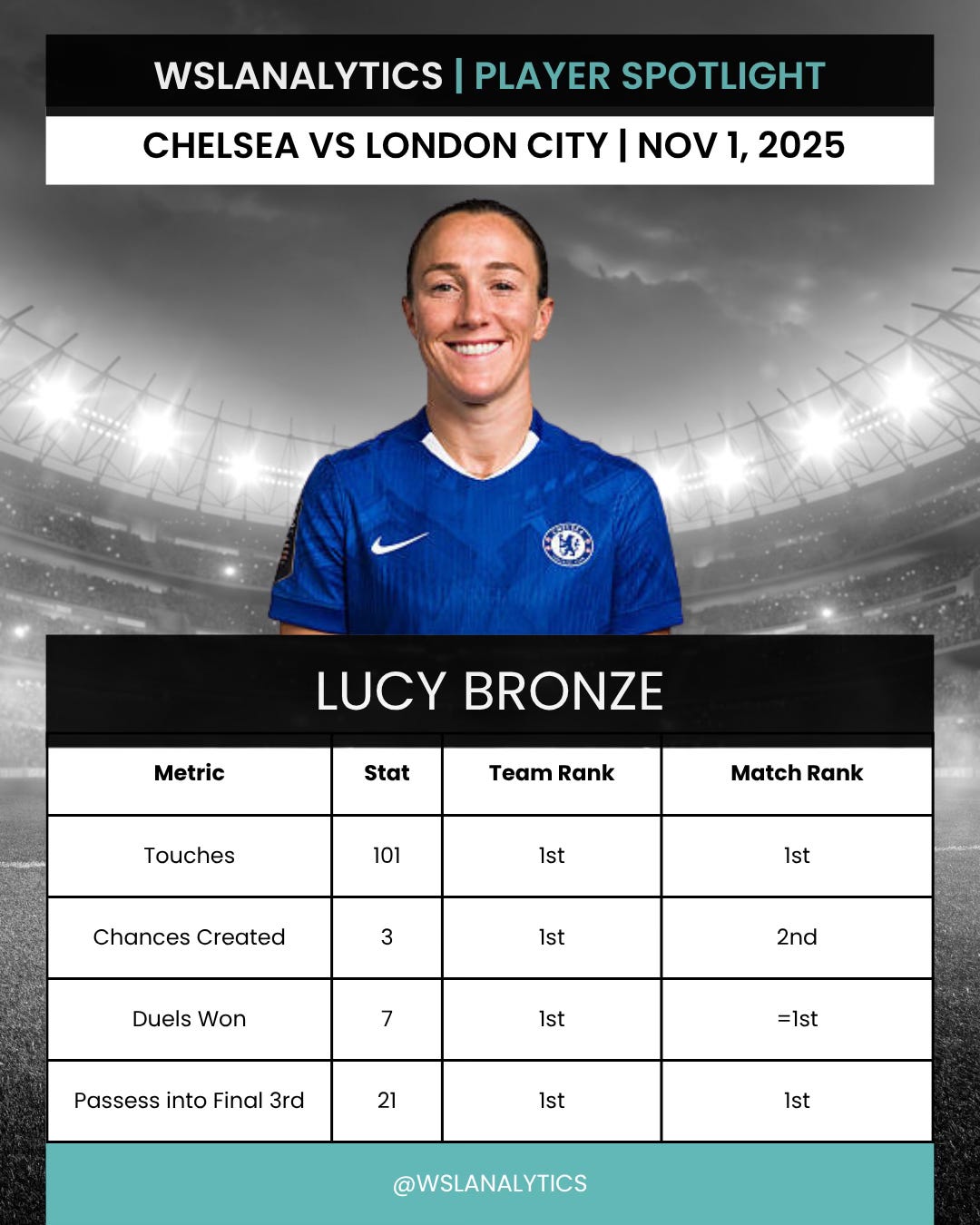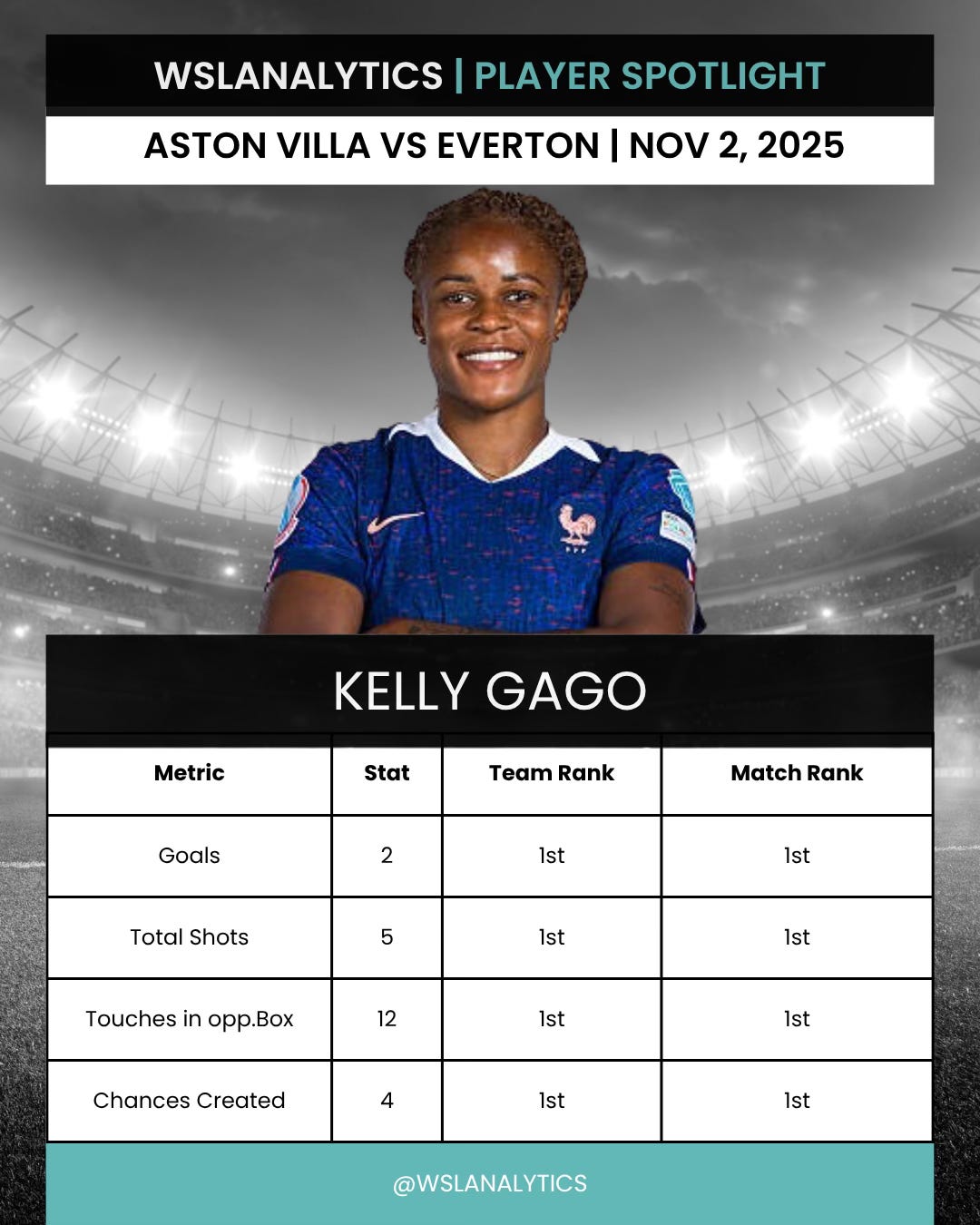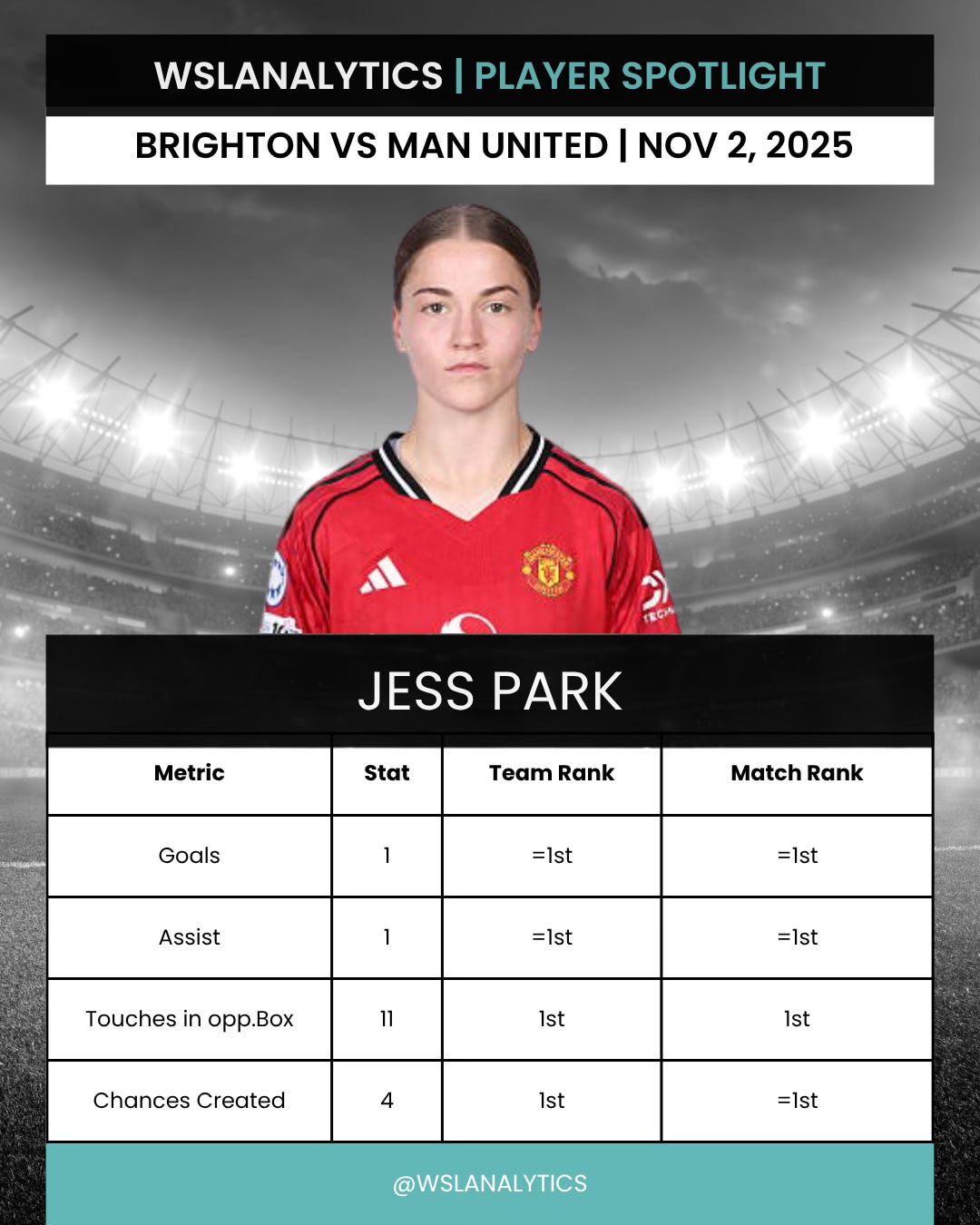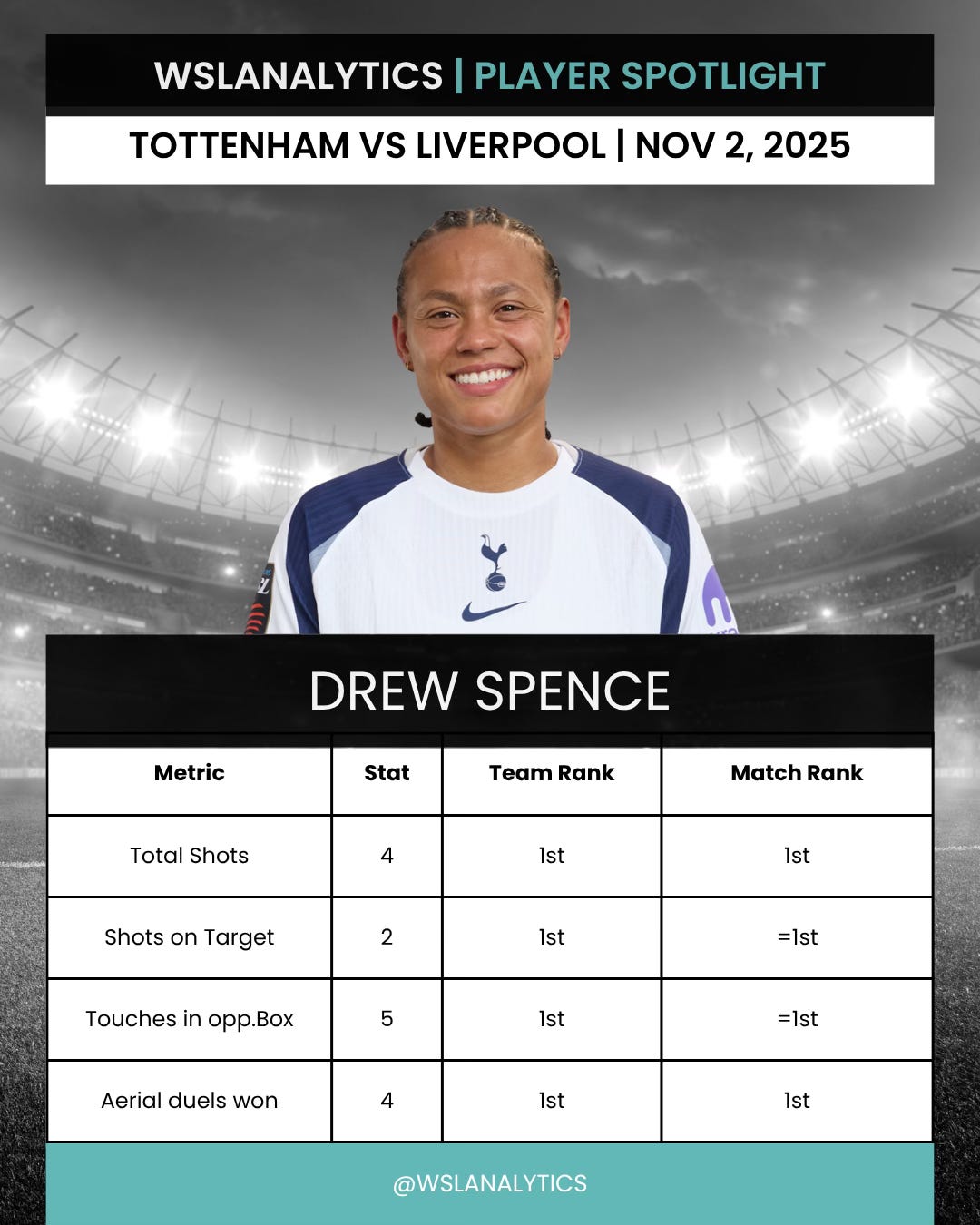WSL 2025–26 Gameweek 7 Recap: Control at the top – jeopardy everywhere else
Chelsea and City grind out wins; Arsenal ruthless; United edge a thriller; Villa–Everton goes wild; Spurs come from behind vs Liverpool.
Overview
Gameweek 7 delivered in 22 goals across six fixtures – joint-highest of the season – and mostly went to script at the top: Chelsea handled business 2–0 in front of 10,441 at Stamford Bridge; City ground out a lean 1–0despite heavy xG control; and Arsenal ran riot 4–1 at Leicester with Stina Blackstenius front and centre. Manchester United shaded 3–2 at Brighton, Tottenham turned 0–1 into 2–1, and Villa–Everton produced a breathless 3–3. In model terms, Chelsea/City/Arsenal tracked the expected outcomes, while Spurs–Liverpool landed in the one-goal band our preview flagged.
Match-by-Match Breakdown
Chelsea 2–0 London City Lionesses
Venue: Stamford Bridge (London) | Attendance: 10,441
Chelsea handled business at the Bridge with a front-loaded start and a late seal. Ellie Carpenter struck inside six minutes to put the champions in control, and Samantha Kerr added a stoppage-time second on 90+4′ to cap a performance built on territory and repeated box entries.
Key stats that influenced the outcome
Shot profile & chance quality: Chelsea led 17–11 on shots and 3–3 on target, but crucially created 5 big chances to 2 – the better looks belonged to the hosts.
Control & territory: Possession finished 57%–43% with an edge in completed passes 391–276. Corners ended 9–1, a good proxy for where the game was played.
Box occupation: Chelsea registered 39 touches in the opposition box to LCL’s 24 – sustained presence around the area that eventually told.
Defensive management: Despite LCL’s late forays, Chelsea limited clear sights; the visitors’ 11 shots yielded just 0.71 xG to Chelsea’s 2.62.
Player spotlight – Lucy Bronze (Chelsea, RM)
Retrospection
Our GW7 preview framed this as a mismatch – Chelsea 82% win probability, with most-likely scorelines 3–0 / 2–0 / 4–0 and a clear squad-value gap. It was also the first WSL meeting between the sides. The 2–0 result tracked the model almost perfectly – early breakthrough, territorial control, late clincher – exactly the manner of win the numbers pointed to.
Manchester City 1–0 West Ham United
Venue: Joie Stadium (Manchester) | Attendance: 2,267
Aoba Fujino decided it with a first-half strike, guiding City past a stubborn West Ham. The hosts controlled territory and tempo throughout, but a combination of missed chances and Hammers’ resilience kept the margin narrow.
Key stats that influenced the outcome
Shot profile & chance quality: City led 18–5 on shots but it finished 1–1 on target. Expected goals told a clearer story: 2.10 vs 0.52 to City, with big chances 4–1 (City missed three).
Control & territory: Possession ended 68%–32% for City. They completed 509–233 passes (accurate: 414/81% vs 172/74%), pinning West Ham deep for long spells.
Box occupation: City generated 12–4 shots inside the box and earned 6–1 corners – sustained presence around the box, however they failed to register it where it matters more – on target.
Defensive management: West Ham limited City to just one shot on target for the entire 90 mins. This might end up as one of the anomaly of the season.
Player Spotlight – Vivianne Miedema (Manchester City, CM)
Retrospection
Our preview model framed this as a near-formality – Manchester City 83% win probability with most-likely scorelines 3–0, 2–0, 4–0. The 1–0 result matched the lean but massively undershot the expected margin: City dominated the ball and xG yet put only one effort on target.
Aston Villa 3–3 Everton
Venue: Villa Park (Birmingham) | Attendance: 2,678 (6% capacity)
A roller-coaster at Villa Park finished all square. Gago put Everton ahead on 11′; Villa flipped it through Georgia Mullett (45+7′) and Kirsty Hanson (59′). Hikaru Kitagawa levelled on 70′ (from Martina Fernández), a Ruby Mace own goal (74′) restored Villa’s lead, before Gago struck late.
Key stats that influenced the outcome
Volume vs. efficiency: Everton generated the heavier workload (16–7 shots; 14–7 inside the box) but Villa were the more accurate finishers (5–4 shots on target). Overall xG was near level (1.73–1.82), and xGOT 2.04–1.79 hints Villa’s on-target efforts had more threat.
Control & territory: Possession tilted to Everton 52%–48% with a slight edge in completed passes (343/80%to 330/82%). They also owned 33 touches in Villa’s box to 16 and a 6–4 corner advantage.
Defensive load: Villa’s back line was busy – 35 clearances, 12 interceptions, 7 blocks – compared with Everton’s 19/6/1. The goalkeepers’ ledger read 0–3 saves (Villa–Everton), underlining how little Villa’s keeper actually had to stop despite the three concessions.
Player spotlight – Kelly Gago (Everton, FW)
Retrospection
Our preview framed this as a finely balanced tie, with most-likely scorelines clustered around 1–1 or 2–1 either way. The 3–3 overshot the expected margin but tracked the model’s “knife-edge” read: Villa’s sharper shot placement twice put them ahead, while Everton’s volume and late pressure earned a deserved point.
Brighton & Hove Albion 2–3 Manchester United
Venue: Broadfield Stadium (Crawley) | Attendance: 3,363 (55% capacity)
United edged it 3–2 at Broadfield. Elisabeth Terland put them ahead on 44′, Jessica Park doubled it on 58′ from Ella Toone’s pass, and though Fran Kirby pulled one back on 68′, Lisa Naalsund made it 1–3 on 89′ (Park assist). Kiko Seike struck at 90+2′, but United closed it out.
Key stats that influenced the outcome
Finishing edge: United put 9 of 18 shots on target to Brighton’s 3 of 16, and led xGOT 3.81–0.95, reflecting far cleaner shot placement.
Chance quality vs volume: Overall xG favoured United 2.32–1.30 despite Brighton registering more big chances (3–2) – the visitors created steadier pressure, Brighton’s best looks were more sporadic.
Control in the middle third: Possession 54%–46% to United; accurate passes 399 (82%)–317 (76%) from 488–415 attempts.
Box occupation & territory: United had 38 touches in the opposition box to Brighton’s 27 and matched clearances 20–20, an indication that both sides came for the win.
Goalkeeping workload: Brighton goalkeeper made 6 saves to United’s 1, a pointer that this could have been worse for Brighton.
Player spotlight – Jessica Park (Manchester United, FW)
Retrospection
Our preview model leaned Manchester United (55%) with most-likely scorelines 0–2, 0–1, 1–2. The 2–3 away win matches the call on outcome and the “one-goal game” range, with United’s superior shot quality (9 SOT, xG 2.32) ultimately deciding it.
Leicester City 1–4 Arsenal
Venue: King Power Stadium (Leicester) | Attendance: 3,923 (11% capacity)
Arsenal tore out of the blocks and had the game wrapped up by half-time. Alessia Russo opened on 7′ from close range after Stina Blackstenius slipped her through, a Sari Kees own goal made it 0–2 on 32′, and Blackstenius added a composed third four minutes later. Leicester rallied late through Noémie Mouchon (84′), but Blackstenius restored the three-goal cushion a minute after the restart to seal a commanding away win.
Key stats that influenced the outcome
Shot profile & chance quality: Arsenal led 18–5 on shots and 6–3 on target. Expected goals underscored the gap (1.90 vs 0.52), with xGOT 3.51–0.74 showing superior shot placement. Leicester had the edge in big chances 2–1, but Arsenal had far more shots in the box: 17–3.
Control & territory: Possession finished 71%–29% to Arsenal. Passes completed were 480 (86%) vs 153 (64%) from 561–238 attempts, reflecting long stretches of Foxes defending. Corners ended 13–2; touches in the opposition box 37–16.
Defensive workload: Leicester’s back line was under siege – 30 clearances, 26 tackles, and 5 saves, however, that could not stem Arsenal’s repeated entries. Arsenal needed just 2 saves at the other end.
Player spotlight – Stina Blackstenius (Arsenal, FW)
Retrospection
Our preview model had Arsenal as heavy favourites (83% win probability) with most-likely scorelines 0–3, 0–2, 1–3. The 1–4 result and underlying dominance (71% possession, 37 box touches, 1.90 xG) tracked the model almost perfectly – just with a slightly fatter margin.
Tottenham Hotspur 2–1 Liverpool
Venue: BetWright Stadium, London | Attendance: 1,674
Tottenham overturned an early deficit with a swift response and then managed a control-heavy second half. After Beata Olsson gave Liverpool a 0–1 lead (11′), Toko Koga equalised eight minutes later (19′). Bethany England struck just after the restart (52′) to give Spurs the eventual match winner.
Key stats that influenced the outcome
Shot quality: With xG 1.87–1.34 and xGOT 2.35–1.28, Spurs turned similar overall territory into better chances and placed them on frame (5–3 SOT). That efficiency explains how they overturned the early 0–1 and then protected a 2–1 lead.
Restarts tilted the game state: A huge edge on dead balls – corners 10–3 and 1.03 set-play xG kept Liverpool under repeat pressure. Those sequences generated the volume that produced the equaliser and the second-half winner, even with open-play possession roughly level.
Territory without penetration vs penetration without volume: Liverpool logged more opposition-half passes (137–107) but Spurs owned the danger zone (23–19 box touches).
Player spotlight – Drew Spence (Tottenham, AM)
Retrospection
Our preview model leaned Spurs (47%) with most-likely scorelines 1–0, 1–1, 2–1. The notes also highlighted Liverpool’s recent unbeaten run vs Spurs and that Tottenham hadn’t beaten LFC in the league since 2019, framing this as a tight one-goal game if Spurs didn’t convert early – precisely how it played out after England’s 52′ winner.
Final Word
If GW7 had a headline, it’s small margins with big consequences – the contenders keep banking points while the middle third squeezes tighter.
If you found this review insightful, please consider subscribing and sharing – and join the conversation on X (Twitter) @WSLAnalytics for more WSL analysis all season.
Missed our Matchweek 7 Preview with win probabilities and forecast scorelines?
Read it here









